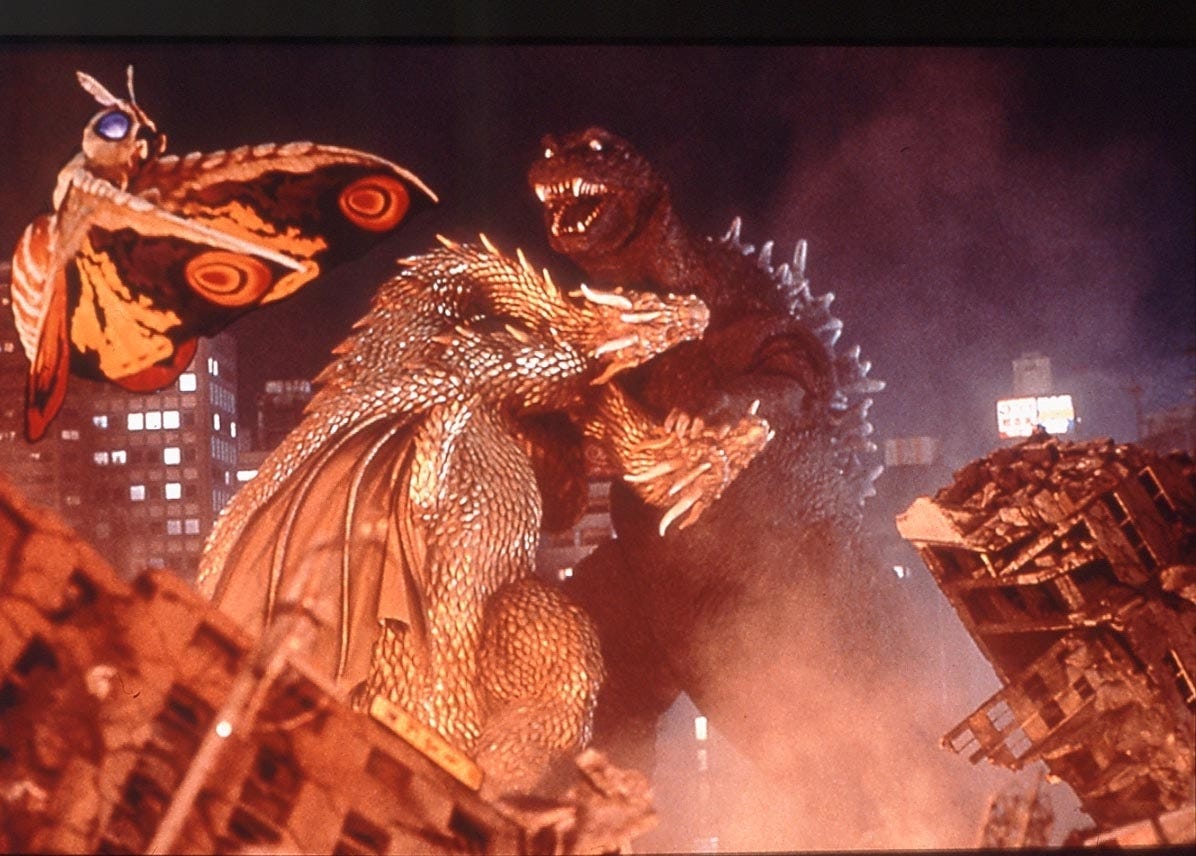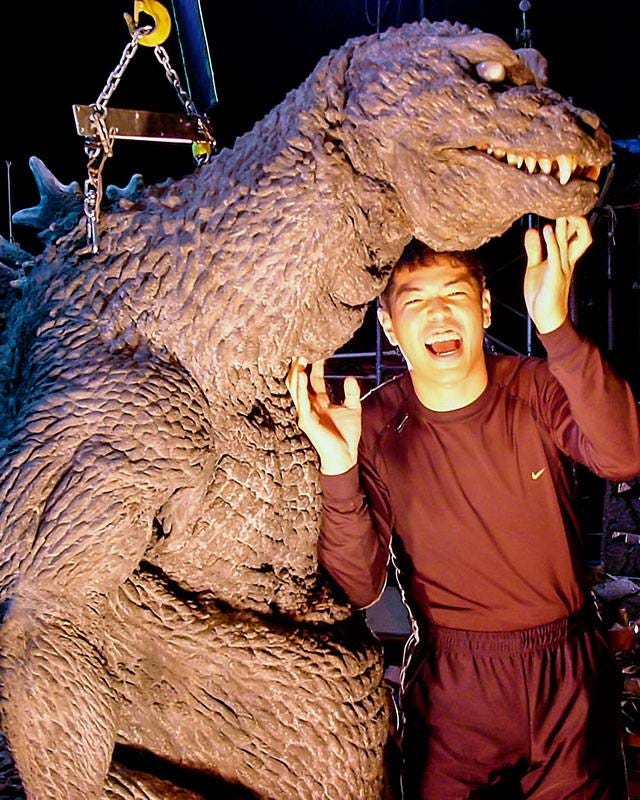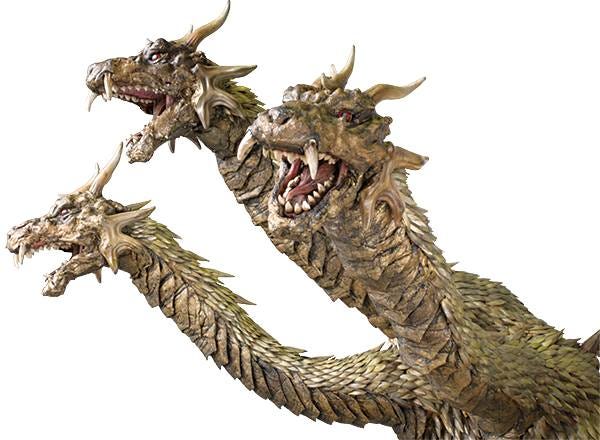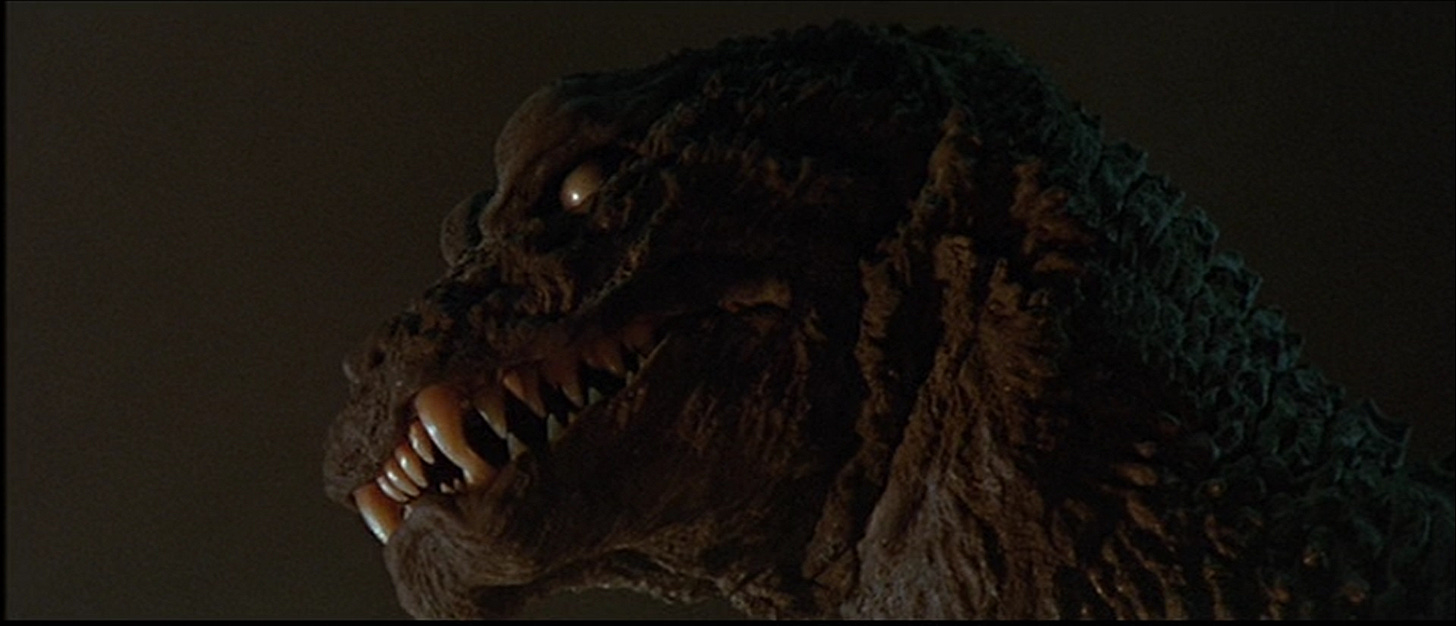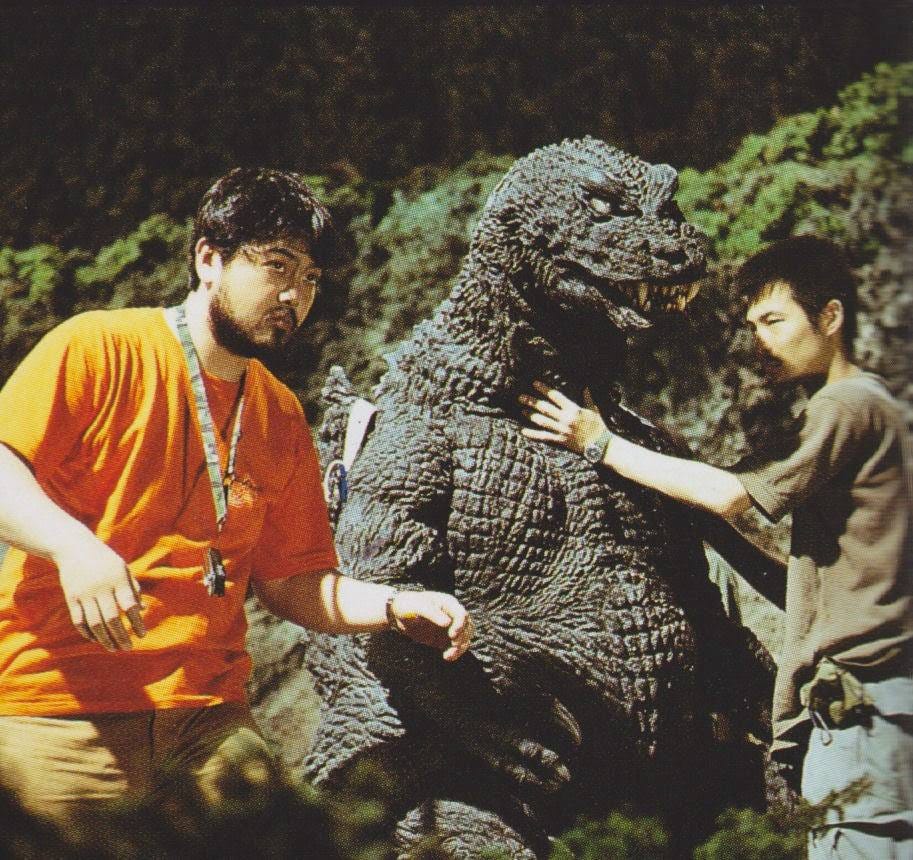Before Shin Godzilla - Retrospect of the Last Era, Part 3: Godzilla, Mothra & King Ghidorah
(Note: Article originally published on October 7th, 2016 in Godzilla-Movies.)
This is Part 3 of a retrospective covering the Millennium Godzilla series. To read Parts 1 and 2, click below:
Before Shin Godzilla - Retrospect of the Last Era, Part 1: Godzilla 2000
Before Shin Godzilla - Retrospect of the Last Era, Part 2: Godzilla x Megaguirus
“Aspiring sincerely to an international peace based on justice and order, the Japanese people forever renounce war as a sovereign right of the nation and the threat or use of force as means of settling international disputes.
In order to accomplish the aim of the preceding paragraph, land, sea, and air forces, as well as other war potential, will never be maintained. The right of belligerency of the state will not be recognized.” - “The Constitution of Japan”, Chapter II, Article 9 (13)
"Those who cannot remember the past are condemned to repeat it." - “Reason in Common Sense”, George Santayana
In 1992 a young filmmaker, Shusuke Kaneko, lobbied to direct Godzilla vs. Mothra. Producer Shogo Tomiyama shot him down, opting for in-studio talent (Takao Okawara). Fearing he would never get a chance to direct a kaiju movie, Kaneko eventually accepted the task of reviving Daiei's Gamera franchise. (1)
Costing a fraction of Toho’s Godzilla films of the time, Gamera: Guardian of the Universe (1995) was an unprecedented success. As late as 1997, every single one of Toho's 1990s Godzilla films had failed to garner interest from overseas distributors. The studio had been under the false impression that the only way to reach a broader, international audience was to throw more money at their films. Meanwhile, Kaneko's Gamera was given immediate State-side distribution, theatrical screenings and praise from even western critics. The result left egg all over Toho's face. (1)
Nearly a decade later, it was Tomiyama who asked the seasoned Kaneko to helm Godzilla. (1) Directing Toho's Pyrokinesis (2000) proved himself familiar enough with the strict studio system to achieve his childhood dream. “I have sort of a dream-like feeling, a special enthusiasm or admiration for a huge object, a giant monster,” said Kaneko. “Godzilla has been imprinted in my blood since childhood.” (2)
After a brief scare that 2001 would be void a Godzilla film, “Godzilla 2002” was made official on January 18th. (1)(3) Kaneko was given more freedom than most Godzilla directors in recent years—Perhaps not since Ishiro Honda himself. (4) As a result, the production crew was largely overhauled from the last two movies.
Former special effects director Kenji Suzuki's career was all but dead after Godzilla x Megaguirus (2000) and Kaneko had originally intended to fill the role. “Because of time, I couldn’t do as much as I originally thought. So I changed my mind along the way, and I thought Kamiya should get his due, so I made sure he got credit as special effects director.” (2) Makoto Kamiya had been Shinji Higuchi's assistant special effects director on the Gamera Trilogy. He surrounded himself with fellow Higuchi protege, Toshio Miike and Kiyotaka Taguchi to achieve similar results. Miike, who had worked on Gamera 3: The Revenge of Irys (1999), provided Kamiya with gorgeously detailed miniatures. Meanwhile, Taguchi (who would later head visuals for Higuchi's MM9 [2010] and his own Ultraman X [2015]) was appointed assistant special effects director. (9)
Shinichi Wakasa's bright green, angular Godzilla was replaced by Fuyuki Shinada's more traditional, yet nightmarish interpretation. (1) Shinada was responsible for some of the most inspired monsters in kaiju eiga, including Biollante, Legion and Iris. (5) His Godzilla stood at a towering seven feet, the tallest in the history of the series. Unlike Wakasa's suit, the head featured heavy animatronics allowing Godzilla to be more expressive than before. In addition to turning his head and nodding, Godzilla could blink, furrow his brow and curl his lips without the need of a secondary animatronic for close-ups. The chest could also rise and fall to simulate deep breathing and the dorsal fins were capable of retracting—Unfortunately, these effects are lost on-screen. (8)
Replacing Wataru Mimura and Hiroshi Kashiwabara, Kaneko shared writing duties with Masahiro Yokotoni (Pyrokinesis) and Keiichi Hasegawa. Hasegawa was a prolific writer for the successful slew of recent Ultraman iterations—Particularly Ultraman Tiga (1996-97) and Ultraman Dyna (1997-98). He would later write the highly praised film Ultraman: The Next (2004) and its follow-up series, Ultraman Nexus (2004-05). (6) The immensity of his involvement with Godzilla has never been given due credit. Hasegawa paved the way for stronger character invention in modern tokusatsu, making him the perfect man to re-establish a sense of humanity in the Godzilla series. “It goes without saying that Hasegawa played an important role in complicating the tone of tokusatsu series, subjecting the heroes to adversity and forcing them to grow and change as people rather than remain as static heroes.” (7)
Outside studio talent converged and pre-production started in January. (3)(9) However, it was clear Kaneko's artistic sensibility was clashing with Toho's commercialism. The screenplay originally called for Baragon, Varan and Anguirus to star alongside Godzilla. After all-new monsters failed to draw an audience in the last two films, Toho insisted upon the use of their most marketable beasts, Mothra and King Ghidorah. (1)(2) “I thought enemies with a similar appearance would work well within this story concept, so that is why I picked them [Baragon, Varan and Anguirus]. I didn’t want to show the other monsters to have any special powers to instead emphasize Godzilla’s powers, so I went for monsters more on the quiet side,” Kaneko explained his original vision. “Then, Toho’s chairman, Mr. Matsuoka, who is a more powerful guy than the president of Toho, ordered me to use Mothra and King Ghidorah.” Although Kaneko admitted it was a smart business move, his opinion on the decision mirrors most fans'. “I still have the feeling that Varan, Baragon, and Angilas..... could have been better.” (2) Shinada, excited about the prospect of creating a new Varan, was allegedly unhappy about the “cast” change. Amusingly, he wove Varan's design into King Ghidorah's face to get some of the beast on screen.
On March 6th, the title Godzilla, Mothra and King Ghidorah: Giant Monsters All-Out Attack, (GMK for short) was announced. Kaneko would be hard at work storyboarding the film as Kamiya prepped special effects shooting for May. (9)(10) Kaneko followed suit with the dramatic footage by the end of the month. (9) In the meantime, Tomiyama put on his salesman hat to keep the hype train going, “We are confident GMK will be the best film in the entire series,” he proclaimed at a June press conference.
Toho, however, didn't want to take any chances. GMK was being targeted primarily at adults, but Toho had felt children were a large part of their audience. To pull younger audiences into the film Toho had made an arrangement with Shogakukan to run the shorter, animated Hamtaru film, Hamtaru – The Adventure in Hamu-hamu Land, before GMK. (1)(12) "The children who saw King Kong vs Godzilla are now in their thirties and forties, and their kids are fond of Hamtaru. So this will please both of them,” said Tomiyama, who blamed the 1998 film for children's lack of interest in Godzilla. "The Tristar Godzilla made the kids believe that Godzilla is for adults only. I hope this will make a chance to correct their current belief.” (12)
Although GMK has a fair share of fun and wit that younger audiences can enjoy, making it easily accessible, it's infused with very real cultural issues prominent today. Since the late 1990s a nationalist group known as Nippon Kaigi has pushed for Article 9 of the Japanese Constitution to be revised. (15) Interpreted as forbidding the nation to posses an offensive army, including nuclear weapons, changes to the Constitution could potentially contradict Japan's non-nuclear weapons policy. Prime Minister Shinzo Abe, who has ties with Nippon Kaigi, has since expanded the interpretation of Article 9 to defend Japan's allies. The change was considered a constitutional violation due to Abe circumventing the amendment process. (16)
Abe's nationalistic intentions also included dusting Japan's Second World War atrocities under the rug. In 1997 he pushed the Japanese Society of History and Textbook Reform into action, omitting many violent acts Japan committed during the war. “Only 19 of the book's 357 pages dealt with events between 1931 and 1945,” said former Japanese student Mariko Oi of her history textbook. “There was another sentence on the Koreans and the Chinese who were brought to Japan as miners during the war, and one line, again in a footnote, on "comfort women" - a prostitution corps created by the Imperial Army of Japan.” (17) Per Abe's orders, any mention of “comfort woman” sold into sexual servitude disappeared from middle school Japanese textbooks by 2004. (18) Oi criticized Abe for wanting, “to change how history is taught in Japan so that children can be proud of our past.” (17)
Weary of these incoming revisions, Kaneko took issue with it throughout his film. The Ministry of Education had also attempted to put a less negative spin on Japan's involvement in the Pacific War. (19) Because the events in the Pacific led directly to the atomic bombings of Japan, the topic was perfect for a Godzilla movie raising the issue of cultural repression toward wartime atrocities.
In GMK Godzilla is embodied by the collective souls of those who died in the Pacific War – Japanese, Americans, Chinese – everyone who died fighting in the Pacific was now fueling Godzilla's rage against Japan. The idea was hardly a new one. In 1954 Akira Ifukube examined audience interpretation of Ishiro Honda's original Godzilla. “The terror of the times was such that people thought Godzilla might be the symbol of the spirits of the departed soldiers at sea.” (20) Professor Norio Akasaka echoed Ifukube's words, calling Godzilla a, “representation of the spirits of soldiers who died in the South Pacific War.” (1)(20) Shusuke Kaneko literalized this concept to raise the issue of Japan's push for historical revision.
The violent Godzilla in GMK introduces himself to a generation that has long forgotten him and seemingly punishes them without remorse. There are instances in the film where the legend of Godzilla is treated like a joke, but the reality of his existence usually comes down on victims with debris and hellfire. Both Godzilla and the souls of war are screaming at a country to wake up, acknowledge their past and take responsibility for their wartime actions. Kaneko's use of Godzilla isn't unlike Professor Akasaka's comparison of the monster to Yukio Mishima's story, “The Voice of the Fallen Hero Spirits”. In Mishima's tale, souls of kamikaze pilots from World War II charge the emperor for falsely claiming he was a god and hold him responsible for Japan's moral and spiritual decadence. (1)(20)
The Pacific War was merely one facet Kaneko used to address Japan's historical revisions. The souls embodying Godzilla could just as easily have been the Imperial Army's comfort women, whose memory today faces a possible revision. (17) In 1954 Godzilla was the symbol of post-war anxieties, but in 2001 he’s a violent specter for post-war amnesia.
For all that GMK does to entertain with striking monster battles and some of the series' finest visuals, it also took the time to give audiences something to chew on. Godzilla, Mothra and King Ghidorah: Giant Monsters All-Out Attack opened December 15, 2001 to become the most successful film of the Millennium Series. Theaters and market experts took note that the majority of the children who had come to see the 50 minute Hamtaro movie stayed for Kaneko's grand epic. (1) The movie remained in the top ten for many weeks and pulled in 2.4 million attendees—Doubling Godzilla x Megaguirus’s numbers. In 2002 it was honored with a Japanese Box Office Award. (24)(21) The movie was well received in the west as well. During a 2002 screening at the American Film Market Kaneko's screen credit was applauded. Immediately after, critics praised the film as a return to symbolic form. (24) The future of the Godzilla series had been riding on the success (or failure) of GMK and it delivered with a resounding sigh of relief. (4)
Kaneko was reportedly offered the director's chair for the next Godzilla project, but declined the position. (24) Toho's suffocating schedule was tough on the auteur, citing time as a frustrating constraint. “At Toho, we can only afford a short time for getting ready and for post production. Toho has their own theaters, so they want to release movies around New Years every year. That deadline is immovable.” Regardless, he was enthusiastic about the prospect of someday returning to the series. “Oh, yes! I would like to make another Godzilla,” he beamed. “I’d do it even under the same conditions.” (2) In 2007 Kaneko maintained a desire to come back when asked what his dream project would be. “Gamera vs. Godzilla,” he replied. “It would be difficult to have a co-production between the two companies Toho (Godzilla) and Daiei (Gamera).” (23)
When Kaneko exited he left a Godzilla that had once again made a connection with the audience. GMK's images weren't merely commercial, they had resonance. (1) The trend would not continue, but the impression would remain. Fifteen years later Godzilla, Mothra and King Ghidorah: Giant Monsters All-Out Attack is as relevant as ever to a Japan at odds with its own past.
--
Sources:
1) A Critical History and Filmography of Toho's Godzilla Series, 2nd Edition - David Kalat
2) Shusuke Keneko Website – Interview
3) Fandom.com/Godzilla – 1/18/2001
4) Cinescape.com/Godzilla - Nail Biting Time for Toho Execs
5) When Roses Attack: 25 Years of Godzilla vs. Biollante with Ed Godziszewski
6) IMDb - Keiichi Hasegawa
7) Isn't It Electrifying? - In Search of Heroes of Justice; A Brief Investigation into Anime and Tokusatsu
8) Becoming Godzilla - SokogekiGoji (2001)
9) Fandom.com/Godzilla – Godzilla, Mothra, King Ghidorah Movie Page
10) Fandom.com/Godzilla - News Bytes (4/02/01)
11) Cinescape.com/Godzilla - GMK Press Material Translated
12) Cinescape.com/Godzilla - An Interesting Tag Team: Godzilla and a Hamster?
13) The Constitution of Japan
14) Cinescape.com/Godzilla - GMK: Remembrance of Meaning - John Lipartito
15) The Diplomat - The Quest to Revise the Japanese Constitution
16) The Japan Times - Reinturpreting Article 9 Endanger's Japan's Rule of Law
17) BBC - What Japanese History Lessons Leave Out
18) The Asia Pacific Journal - Critical New Stage in Japan's Textbook Controversy
19) UCSB - Denial of the Holocaust and the Raping of Nanking
20) Toho Kingdom, Talkback: GMK - Godzilla, Mothra and King Ghidorah (2001), from member kpa (Keith Aiken of SciFi Japan)
21) World of KJ, Japanese Box Office, from member Corpse, sourced from Kogyutsushin
22) Monster Zero, TALKBACK #25: GMK, from member kpa (Keith Aiken of SciFi Japan)
23) The Brookyln Rail - Roman-Porno to Desu Noto - The Odyssey of Shusuke Kaneko




